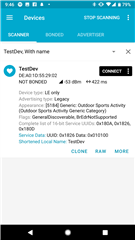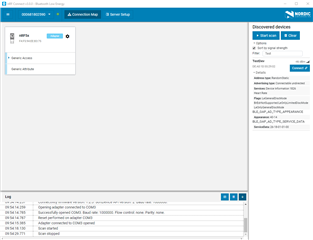Hello!
I am doing some development with pc-ble-driver-py and ran in to some unexpected behaviours when reading characteristics. I have been modifying the nus_collector.py script that was given as an example on this post. I am also using a PCA10028 to scan for devices.
Firstly, when scanning for devices, they last few characters for some devices are missing or corrupted. For example, when receiving the advertising name of a device with the name of "TestDev", the received name is captured as follows:
where the expected output should be:
Upon using nRF Connect (either PC or mobile versions), the correct device name is displayed:


This end of device name string corruption does not just happen for this particular device - I have tested scanning other devices where I see a similar behaviour with differing amounts of corruption (e.g. some devices only have 1 character that is corrupted at the end of the string). However, not all of the devices I have scanned display the corruption; some devices have their advertising names being received correctly.
Secondly, when receiving heart rate notifications from a connected device, the data is tens of thousands of values in length. Is there any documentation on how to convert this data so it can be interpreted in beats per minute (bpm)? Note: the heart rate is correctly displayed on nRF Connect (both PC and mobile).
Here is the modified nus_collector.py script that I have been using to test:
Any help with either of these issues would be greatly appreciated!
Regards,
Scott


